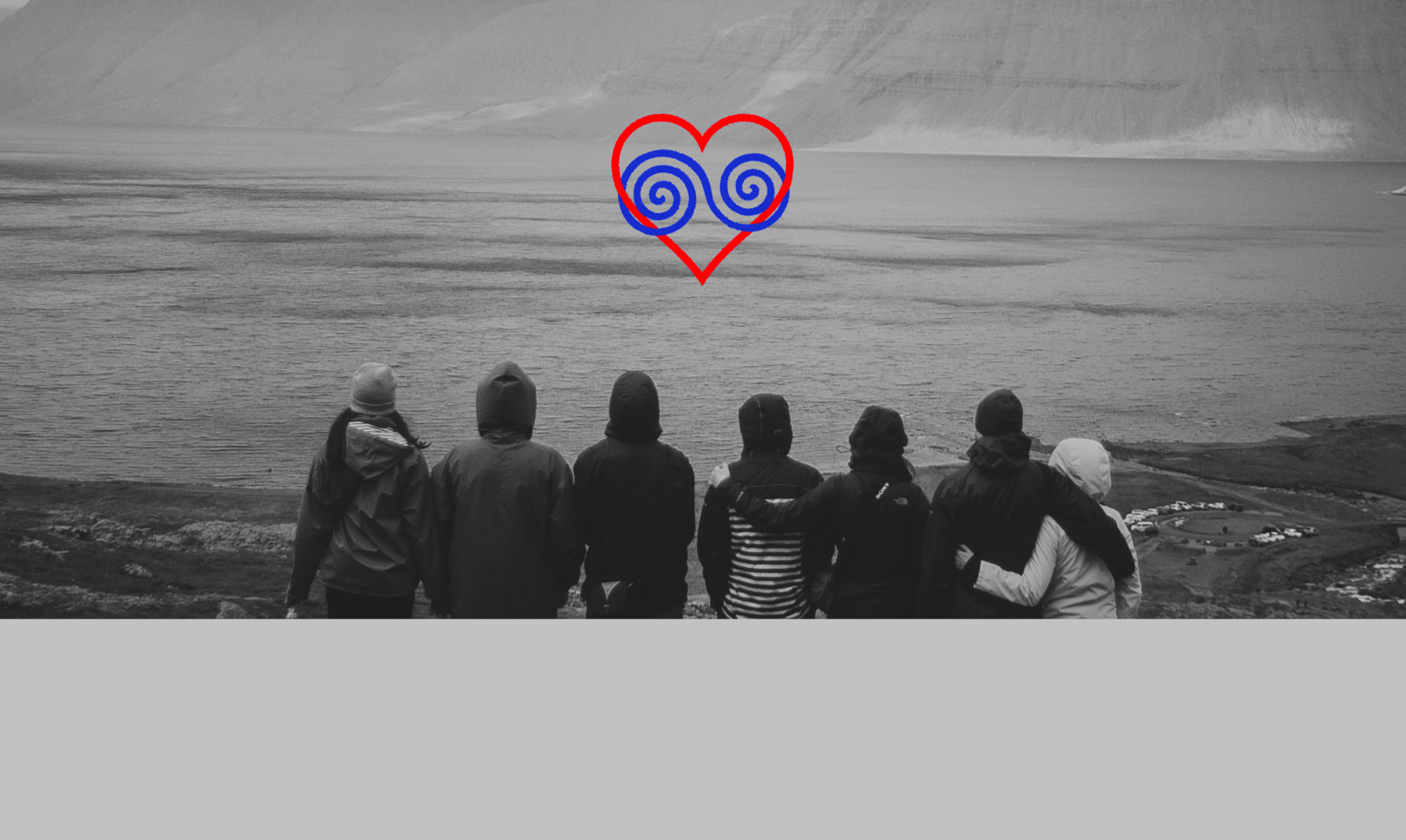Intimacies
Oligoamory
Committed-sustainable multiple relationships with (just) a few participants.
That’s what I started my journey for.
Maybe that’s what you might be looking for, too, dear reader.
What do we wish for?
To be involved in some real, intimate relationships in our lives.
Oh intimacy – so often misunderstood…
Especially since the 19th century, when the little word “intimate” was chosen as one of the many substitutes to avoid the term “sexual” – thereby forestalling that anybody might call certain “things and procedures” by their proper names. Thanks to these times we still use words like e.g. “intimate hygiene”, “intimate shaving” and “intimate piercing” – and all these words quickly become involuntarily funny, if instead of the disguising derivative “intimate” we are trying to use a proper denomination designating the tangible matter. “Intimate”, is as usefull (or rather useless) as the term “private parts “– which explains nothing but that there seems to be something at close range that is very personal and dear to me.
While this prudish sqeamishness from Victorian times may amuse, that shamefaced use of the term “intimate” caused continuing damage until today – “intimate” and its noun “intimacy” are still broadly applied for everything “sexual”. Accordingly we read or hear “intimacies” and we think: “Oh, it’s about sex…! ”
And we, who long for real, intimate relationships, quickly get in trouble – with the outside world and with ourselves. “I see – it’s just about sex! ”, – sometimes it doesn’t matter if an inward voice needles us like that or if our best mate blares it out bluntly.
Ouch!
Twitter activist Sassbox wrote earlier this month:
»We think we want sex. It’s not always about sex.
It’s intimacy we want.
To be touched. Looked at. Admired. Smiled at. Laugh with someone.
Feel safe. Feel like someone’s really got you.
That’s what we crave.«
I’m appreciating such activism, since people like Sassbox are reclaiming a term in this way – thereby restoring its true meaning.
The term “intimacy” stems from the Latin phrase “intimus/a/um” – which is the superlative of the word “intra” (meaning: inside), the comparative “interior” (meaning: more interiorly). Thus, “intimate” means – according to the Online Etymology Dictionary¹: “innermost, deepest”; “closely acquainted, very familiar,” and “inmost, intrinsic”.
Accordingly, we seekers of intimate relationships, in fact, crave for human connections that evoke feelings of deepest attachment, closeness, familiarity and an emotional home.
Hear! Hear!

Anyone who has followed me up to this point may now give me the opportunity to link some “loose ends” that may have been left open by previous expedition entries.
First of all: “a feeling of deepest attachment, closeness, familiarity and an emotional home” corresponds exactly to the ideal state, which Jean Liedloff calls the “continuum” and Daniel Hess calls “Reality of Unity” – and to which I referred in my last Entry 26. Both authors apply their terms to an experience of nearness and intimateness, to a primal ground of perfect cohesion and oneness.
But in Entry 26 I also wrote about a strange dismay and a sudden feeling of shame that sometimes arises when we are confronted with our own urge for closeness and intimacy. Why?
Because we exist in a “Reality of Separation” nevertheless.
And a “Reality of Separation” has two nasty aspects which hamper any emancipated approach back to the lost “primal ground” of unity:
On the one hand, there is the element of elusiveness, which I addressed in Entry 19. As spatiotemporally limited and “finite” living beings we can hardly permanently linger in just one state of existence – even if it is deeply fulfilling. Johann Wolfgang von Goethe depicted this dilemma in his drama “Faust” in a scene where Dr. Faust makes a bet with the devil. Triggering condition of the bet is the following sentence, which Dr. Faust has to utter “If to the moment I should say: Abide, you are so fair”. Dr. Faust – the betting partner of the devil – thus had lost in any case, because the devil plays the ever-changing human mind against our yearning for the lost paradise, the lost “Reality of Unity”, in which everything falls into its place and regarding which we yearn to hold on to forever.
On the other hand, there is the constant “Praise of the Reality of Separation” which we hear almost every minute of the day.
Since the Age of Enlightenment there had been an ever-growing belief in a strong and autonomous self. Therefore, our present morality is often based on maxims such as “The strong one is most powerful alone.²” or “One only can be oneself as long as one is alone: therefore, he who does not love being alone does not love freedom: for only when one is alone , one is truly free.³”. That sounds extreme? Such thoughts don’t have a place in the world of love and multiple relationships? Then I like to link back to my 8th Entry, which I opened with a Rajneesh/Osho quote about our aloneness – or refer to Byron Katie – who is currently in vogue in many polyamorous circles – who postulated in her book, “I need your love, is that true? “(Goldmann 2012) that »other people are just mirrors for our feelings of love that are triggered within us – merely revealing feelings that have been there all along«.
In that kind of “reality” we wouldn’t need other people if we were able to maintain our strong independence and individualism just firmly enough…
But the other people exist nonetheless – and sometimes they can become overwhelmingly “real”. They have their own wishes and needs, which they seek to realise and which they pursue with their own strategies. Like ourselves, they experience fears and hardships which afflict us sometimes (for we are social beings after all).
If we want to fulfill ourselves uncompromisingly, if we want to be completely “free” of alleged restrictions by foreigen strategies and foreigen fears – well, then we have to seek shelter in a “Reality of Separation”. And keep up the daily rat race, which means: Me against “the others”.
And yet: We, the relationship-seekers, still long for intimate connections, for familiarity and togetherness, for the people of our “soul-tribe”, for kindred spirits…
A person in the Middle Ages would probably have been unable to understand our conflict between “unity” and “separation” concerning interpersonal relationships: She or he probably would not have been much aware of any lack of individuality, even of inadequate “individuation”. In everyday life, she/he would also have been constantly surrounded by the people of clan and kin. They would have shared the only bed at night with several people, maybe eaten from the same bowl, on the tight table they would have felt (and smelled) right and left the bodies of the other eaters – work and life would have been entirely embedded in a network which the clan provided. Obvious closeness and familiarity everywhere. “Sometimes it’s almost a little bit too much…“, such a person might have said, thereby knowing fully well how she/he was supported by the entire structure in many ways – and therefore why any personal contribution to it was necessary as well.
But today? We do not live like that any more. We grew up in our “Reality of Separation”, we are used to the fact that divisiveness is regularly emphasised and sometimes obligatory. Ever since the beginning of industrialisation in the late 19th century, we have increasingly been living in small-scale families. And since the 1980s, the “single-lifestyle” has statistically been the fastest-growing sector in all Western industrialised nations.
Additionally, we rarely live and work hand to hand any more. Many of us are pursuing occupations where a screen is the main workplace and the only contact to the outside world – open-plan offices with their isolated cubicles are a sign of the times.
Keyword »time«, which is money, as we all know: Our working hours as well as our mode of working barely allow us any recess for social contact, true conversations or even empathic interpersonal moments. Hugging or touching is also a rarity – our Reality of Separation has ensured with many mechanisms that this terrain as well has become too delicate to cross.
All that results is an empty spot. A void felt by an increasing number of people, who try to counteract this isolation in their lives. People who feel that even in the midst of other people hardly anyone touches anyone else, or even looks appreciatively. Where few people allow themselves a smile and laughter is seldom heard. In such circumstances, you quickly feel insecure. Because in our Reality of Separation, we can hardly recognise who’s really got us….
And amidst all this – there we are – the”relationship seekers”, with our need for closeness, affection and, yes, intimacy.
That’ll be some challenge!
Because – first of all – we have to admit that there is this need inside of us. Admit it honestly to ourselves. And that is not easy because we are violating everything that our surrounding Reality of Separation has taught us: The strongest is most powerful alone – and therefore we MUST NOT need the other people.
And that’s why we’re scared of ourselves or even a little ashamed when we catch ourselves fancying that innermost (intimate!) need. For in the harsh light of a Reality of Separation, we would thus be considered as needy – and as dependent.
Maybe there even is a desire for more than one beloved person… Perhaps our need has become quite strong in many years, sinc in a Reality of Separation, true intimacy is always stinted. In a Reality of Separation the powers that be use such mechanisms to keep us obedient and manageable. Accordingly, in western industrialised nations, there is only one officially sanctioned model in which love and intimacy can be granted among adults: it is called “monogamy” and allows only two providing participants… Anyone who wants to break away from this narrow framework has to be very courageous and non-conformist, because in a Reality of Separation divergent tendencies are seldom welcome and often are branded as extremely frivolous and suspicious.
Anyway. There they are now …: The “other people”. The other people with their petty worries and fears. Parents, children, spouses, friends and lovers…
Finally, despite all the inner adversities, we halfway consolidated our yearnings; contrary to the prevailing forces we try to live a life in which multiple relationships are possible – and there they are, holding us down: These people, with whom one is connected for life in systems of liabilities, commitments and mutual care. We have come that far. But we can never really be free like that – Schopenhauer and Osho and Mrs. Mitchell are quite right: If only we were alone, away from those stupid agreements that we have somehow approved – regarding some people we are related to in lots of intimate ways – we would be soooo much more advanced… (*Irony off*)
Really? You would rather be separate? Because voluntary-conclusive attachment concerning your family or your relationship is too sticky, too restrictive?
Then you think like the wife of the fisherman (“The Fisherman and His Wife“), who is rewarded at the end of the journey with a bitter return to her old hovel: Welcome (back) to your Reality of Separation!
No, you who are still longing, the romantics, the relationship-seekers, on the road to experience true intimacy: Familiarity, appreciation, attachment, and an emotional home are always “inclusive.” These values do not exist detached from your primal ground, but are directly connected with everything that (already) is in your life. And above all, these are the people with whom we already share our lives. Because there exists “intimacy” yet.
And if we really take the term seriously – which I think is what were are bound to do – we should acknowledge that these people are part of our “innermost” being, too. And if I would try to exclude that, I would once again create an artificial separation.
Every new “intimate” relationship that I aspire is connected in my “innermost being” to the existing ones. And that is why I also feel the cares and concerns of my loved ones like my own: I’m not afraid for them because of their cares and concerns or because I have to watch sometimes helplessly from the sideline. In the end it’s always the fear for myself. It’s my fear that I can not fulfil my needs as I would like to do. Fear that suggests, that I would have to split up internally, thereby creating nothing but small, separate units, in which I could only realise bits and pieces of my yearnings. An inner fragmentation concerning which I know that by doing so I will never really experience my inner peace of a “Reality of Unity”, the true “continuum”.
We have to choose the ambitious approach: An approach of trust and integration if we want to experience a oneness of our relations within ourselves. And that’s why it was so important to the writer Saint-Exupéry to point out in his story with the little prince and the fox (chapter XXI) that “getting to know each other, to make oneself familiar” always takes time. Even the “familiarisation” with ourselves. That way we may benevolently recognise how sincere we actually are towards ourselves, how much “unconventionality” we might dare already.
Or whether we are still predominantly falling into the traps of an all too well known “Reality of Separation”, while we are trying hard to reach out for unity and oneness.
That’s what true multiple relationships and ethical non-monogamy are all about. Or, as Morning Glory Zell-Ravenheart said at the end of her article, in which she published the term »polyamorous« for the first time:
“The magic words are still, after all: Perfect Love and Perfect Trust.”
¹ Ethymology Online Dictionary by Douglas Harper
² Friedrich Schiller, “William Tell”, 1802-1804. Act 1, Scene 3
³ Arthur Schopenhauer, German philosopher, from “Parerga and Paralipomena”, 1851
Thanks to Jay-O for calling my attention to the Twitter-quote and thanks to Cathal Mac an Bheatha on Unsplash for the photo.

